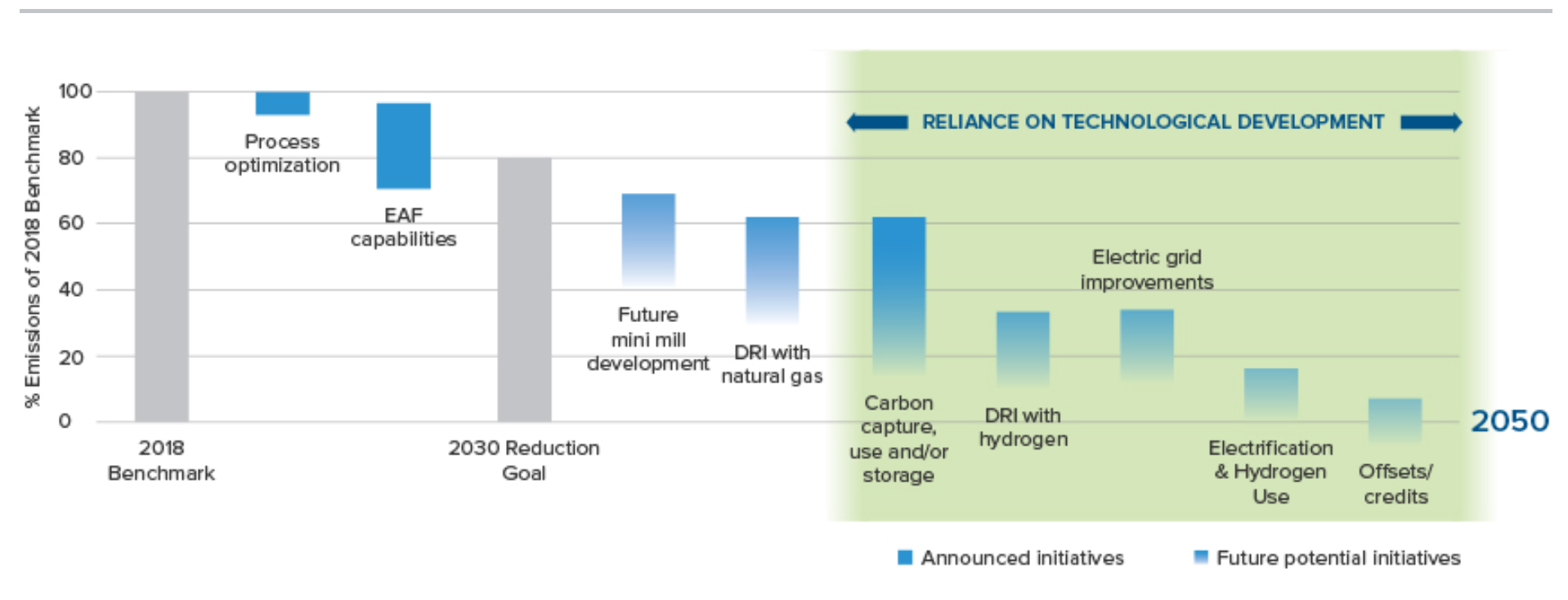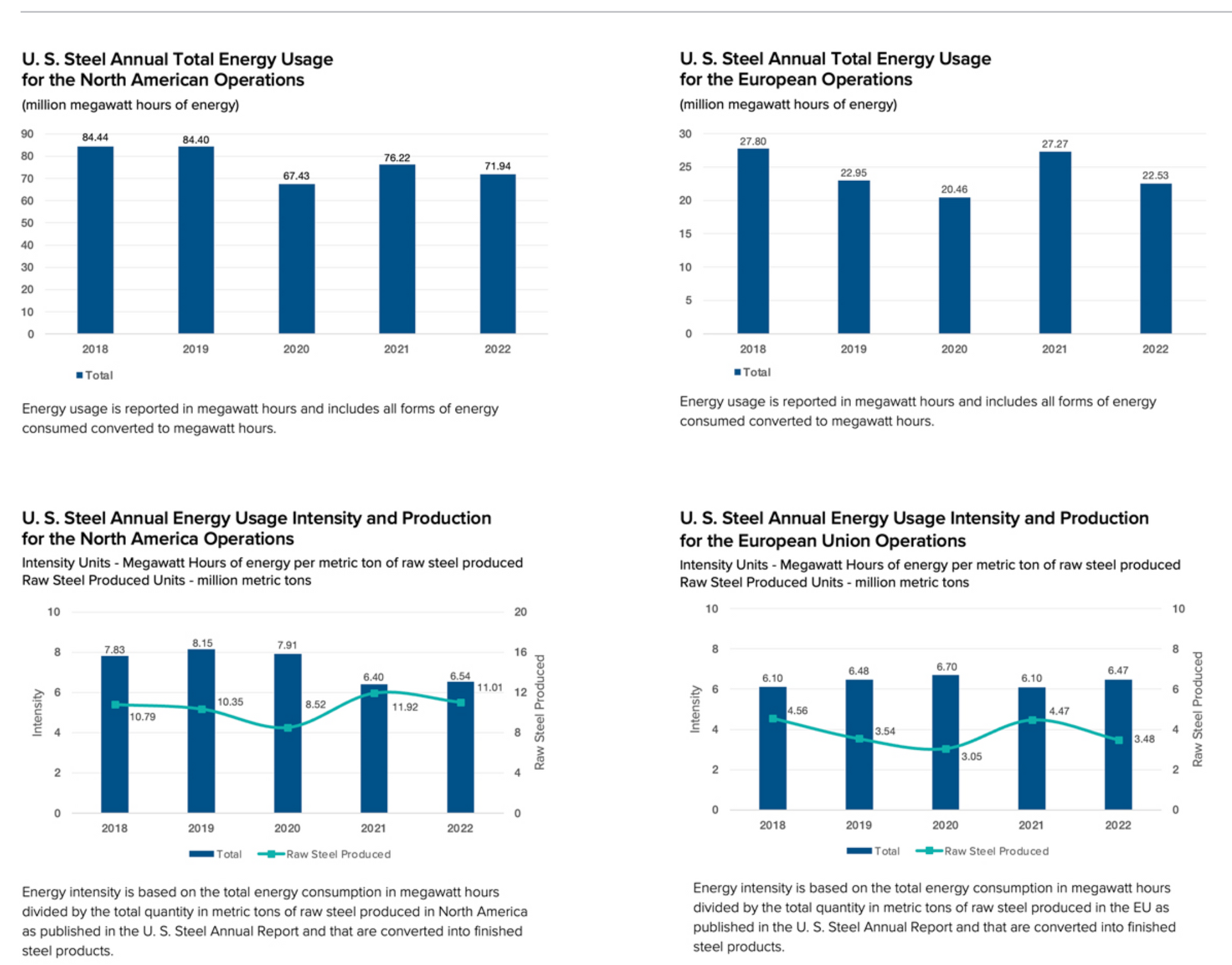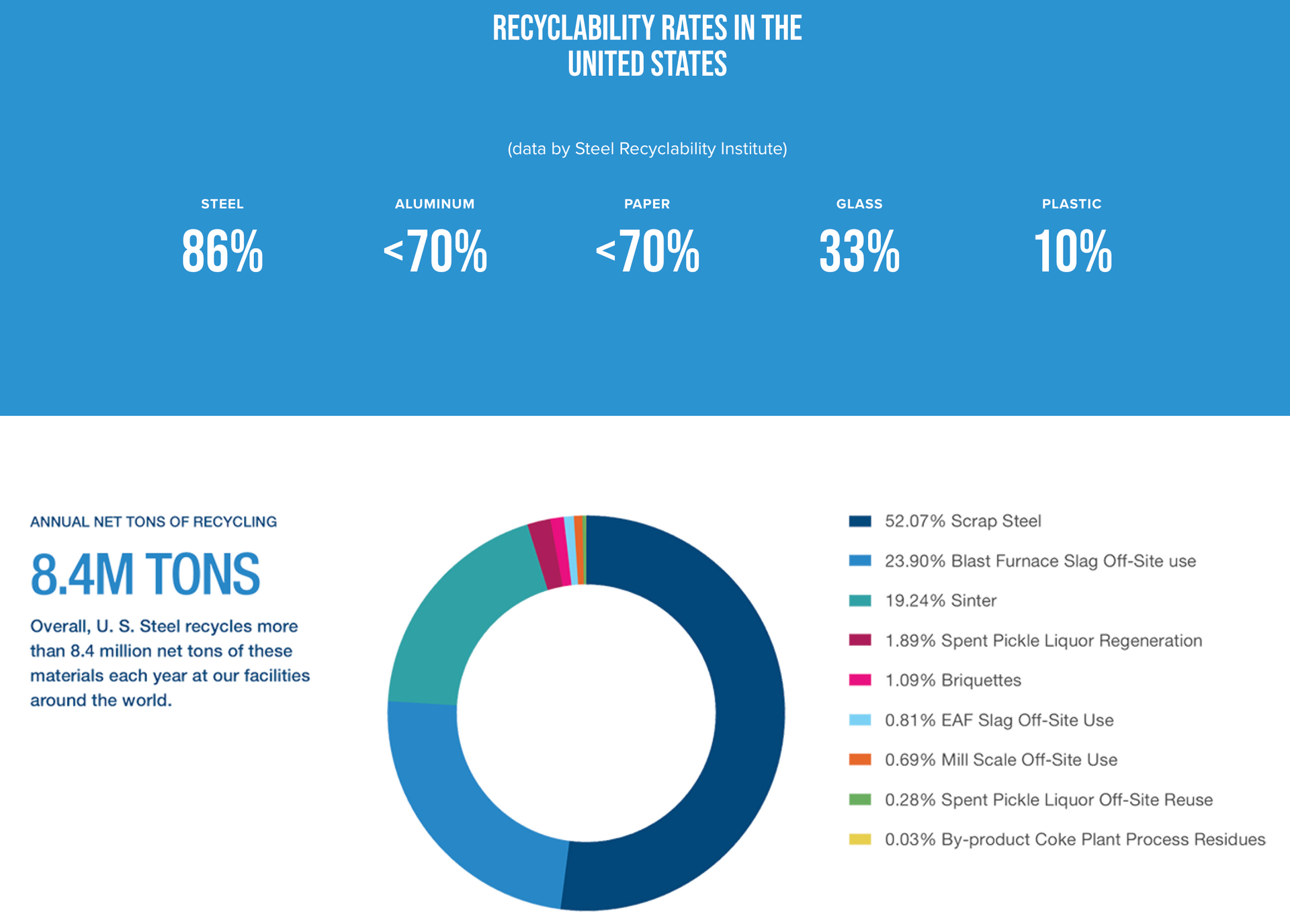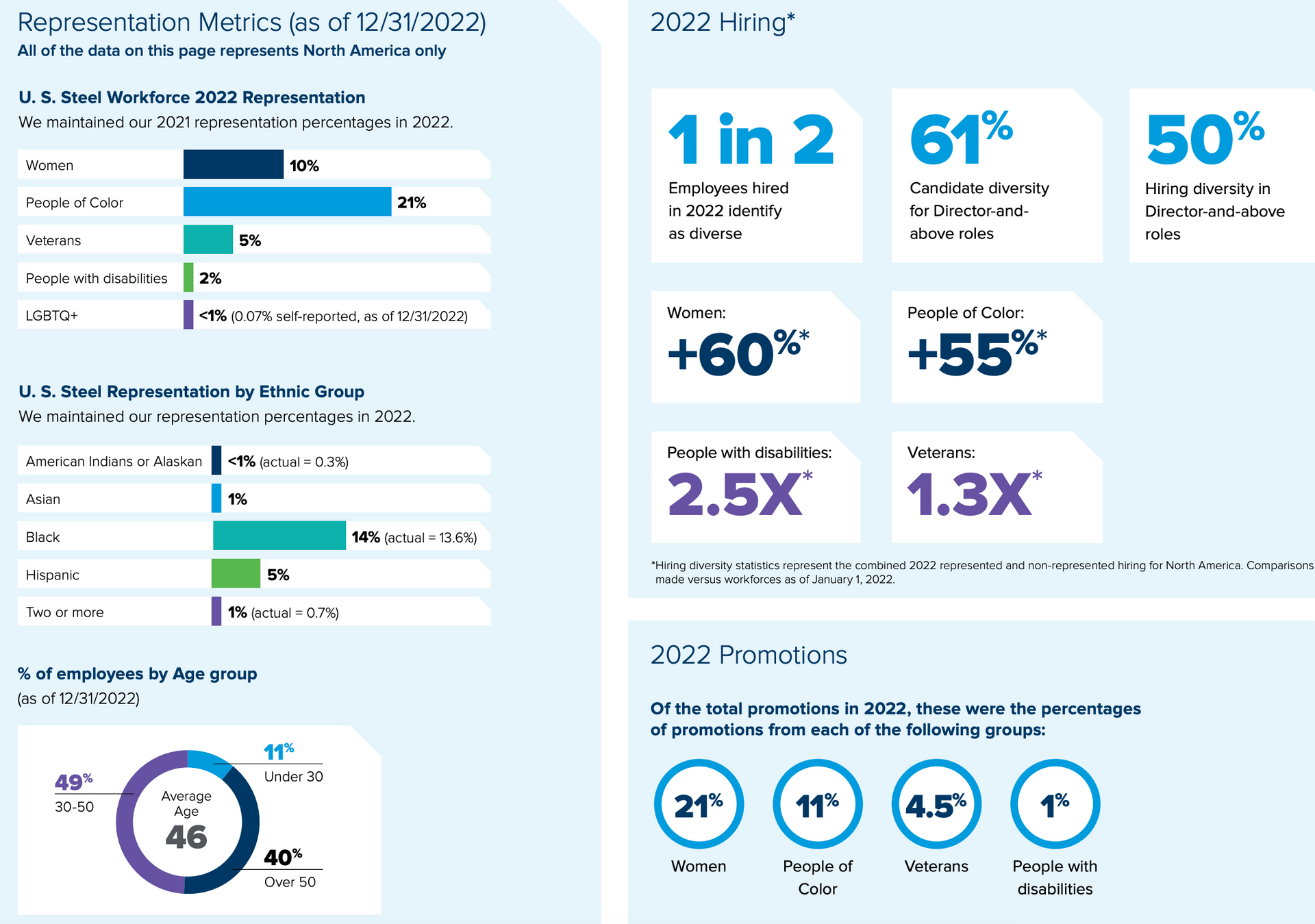Sustainability Goals
2030
- Reduce greenhouse gas emissions intensity by 20% (2018 baseline). Pathways to success include:
- Process optimization and clean energy procurement: For existing operations, we are continuously striving to use less energy, whether that energy is from purchased electricity, purchased natural gas, or the coal and coke used in our processes. Depending on the availability of carbon-free energy, we anticipate that these efforts will result in a reduction of 3-6% in GHG emissions intensity.
- Integrating electric arc furnace (EAF) capabilities into our footprint: Integrating EAF capabilities into our footprint is key to achieving our 2030 GHG goal.
- Reduce corporate NOx emissions by 10% (2018 baseline)
2050
- Achieve net-zero greenhouse gas (GHG) emissions (applies to scope 1 and 2)
- This goal will entail additional EAF deployment and other developments in the industry. Due to the reliance on these future developments the exact timing, location, and final effect on U. S. Steel's emissions is currently uncertain and subject to change as developments occur.
U.S. Steel has identified the following areas for potential emissions reductions and those that require further development to become commercially feasible:
Improvements based on existing technologies
- Future mini mill development: EAF technology, which currently exists and is widely used today, produces steel with approximately 70% less GHG emissions than traditional integrated steelmaking. To achieve net-zero emissions, U. S. Steel will further incorporate and utilize EAF-based/mini mill steelmaking technology in our footprint to achieve our 2050 net-zero goals. The level of improvement will depend on the number of mini mills deployed and could lead to reductions from 10-60% from the 2018 target.
- Direct Reduced Iron/Hot Briquetted Iron (DRI/HBI) using natural gas: Iron ore is currently converted to iron for use in our blast furnaces using coke, a purified form of coal. As we increase our EAF-based steel production, we have the opportunity to utilize less carbon intensive raw materials in the production process. The adoption of DRI/HBI technology using natural gas as the reductant, to convert our iron ore into a product to be used by our growing fleet of EAFs will lead to increased efficiency and ability to incorporate more mini mills into our steelmaking, as well as reduce our reliance on coal and coke. The amount of reduction depends on how many DRI/HBI facilities are deployed but could range from 10-50% reduction from 2030. Natural gas based DRI has been used around the world for almost 50 years and is a mature technology.
Improvements based on technologies that require further development
- Hydrogen-based DRI: Hydrogen-based DRI would replace the natural gas with up to 100% hydrogen. The hydrogen used would be generated from renewable energy (“green” hydrogen). Production of the volume of green hydrogen needed requires a significant build-out of the clean electricity grid, which is why we consider this a future potential technology. The reduction potential depends on the number of DRI facilities constructed, and whether those DRI facilities would start DRI production using natural gas (included in the section above) and subsequently convert to hydrogen DRI production or start up immediately using hydrogen for DRI production. Assuming natural gas based DRI is then converted to hydrogen, we would expect a further 20-40% reduction in greenhouse gas emissions.
- Carbon Capture, Use, and/or Storage: We expect that operational blast furnaces will eventually need to have some sort of carbon capture technology employed to continue operating by mid-century. Carbon capture currently exists in the power industry, however there is limited experience in the steel industry, and we do not expect it to be fully commercialized for at least another decade. This includes the potential of capturing carbon dioxide from our integrated operations (e.g., coke plants, blast furnaces, oxygen steelmaking furnaces) as well as exploring the potential to capture carbon from our EAF-based operations. The amount of reduction depends on the deployment and the future asset base and potential reductions are not estimable at this time.
- Electric grid improvements: Improvements are needed to allow us to obtain reliable, low-cost, carbon-free power at all our operating locations. While we do procure some carbon-free power currently, we consider this accelerating after 2030 due to several factors including:
- Increased deployment of carbon-free energy sources (nuclear, hydro, solar, and wind power)
- Increased ability of the grid to transport electricity from where it's generated to where it's needed
- The growth of short- and medium-term battery storage, to enable carbon-free power when renewables or other carbon-free options are not available.
- Expansion of electrification and hydrogen use: Throughout our processes, we use carbon-containing fuels such as natural gas, diesel, fuel oil, and/or gasoline for process heating, building heating, and transportation. We believe we will be able to reduce our use of these carbon-containing fuels by increasing our use of hydrogen and/or electricity, reducing GHG emissions. This includes using hydrogen or electricity to replace natural gas in hot strip mill reheat furnaces and annealing furnaces, as well as examining the potential for the use of either of these to power light-, medium- and heavy-duty mobile equipment.
- Carbon offsets/credits: To achieve net-zero emissions by 2050, we anticipate any gaps remaining from the above processes can potentially be closed through the use of carbon offsets or credits. Offsets and credits are a last resort, and our preference would be to lower emissions as much as possible through technological means before purchasing offsets and credits.


Latest Sustainability Reporting
Highlights
- Reduced absolute Scope 1 and market-based Scope 2 emissions by about 2.9 million metric tons when comparing 2022 to 2021.
- Continued integration of electric arc furnace (EAF) capabilities into operations, including:
- Acquisition of Big River Steel and completion of the construction of the Fairfield Works Tubular EAF, which resulted in approximately a 10-15% reduction in our GHG emissions intensity.
- Construction of a second mini mill (in Arkansas, near Big River Steel), which will further aid us in meeting our 2030 GHG goal. This second mini mill is expected to be operational in 2024, and with its incorporation of endless casting and rolling technology, we expect to further reduce GHG emissions intensity versus other thin slab casting technologies.
- Other examples include the permanent idling of our Great Lakes Works steelmaking and hot rolling operations. Additionally, we announced our intention to permanently idle Batteries 1-3 at our Clairton Coke Plant by March 31, 2023.
- Received Emission-Free Energy Certificates for five manufacturing sites, one research center and one business service center.
- Surpassed a $300 million spending goal on diverse suppliers by approximately 130 percent.
- Dedicated
2% of total capital expenditures to Environmental capital projects.






Recent News
2024
U.S. STEEL / CARBONFREE — Announced a new agreement for CarbonFree to capture and mineralize up to 50,000 metric tons of CO2 annually from U.S. Steel’s facility in Gary, Indiana. The CO2 will be converted into calcium carbonate, used to create many products. Operations are projected to begin in 2026, with a 20-year term. (April 2024)
Joined the CEF member network in January!
2022
Trane Technologies – Announced it would purchase low-carbon steel from Nucor and U.S. Steel, covering 20% of Trane’s annual steel purchases, and reducing annual CO2 emissions by nearly 16,000 metric tons. The steel will be used to build high-efficiency heat pumps and air conditioners for homes, and thermal management systems for commercial buildings such as schools and data centers. (Nov 2022)
Broke ground on a $3 billion sustainable steel mill in Arkansas. It will feature two electric arc furnaces (EAFs) capable of producing 3 million tons of steel per year and will be the first mill in the country to use endless casting and rolling technology with “significant” energy and efficiency benefits. (Feb 2022)
2021
Announced it will partner with oil and gas producer Equinor U.S. Holdings Inc. to explore the potential for carbon capture and storage, and hydrogen development in Appalachia. (July 2021)
MORE »
How can we help? Please reach out to us!
Laura Keenan, Chair
laura@corporateecoforum.com | (617) 921-2307
Amy O’Meara, Executive Director
amy@corporateecoforum.com | (857) 222-8270
Mike Rama, Deputy Director
mike@corporateecoforum.com | (607) 287-9236
Margaret Fenwick, Program Lead
margaret@corporateecoforum.com I (917) 678-4161
MR Rangaswami, Founder

